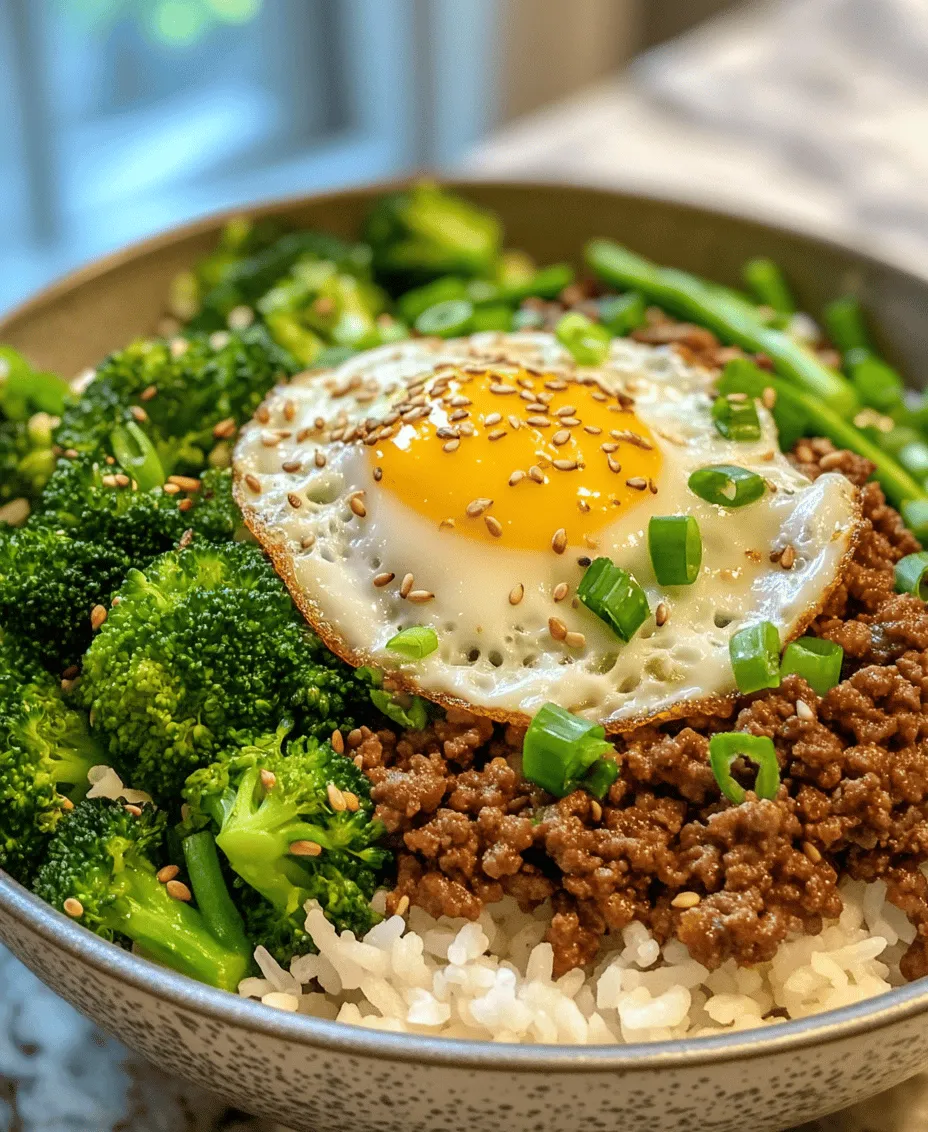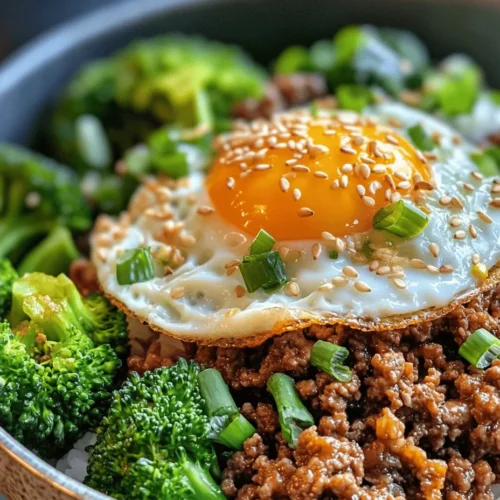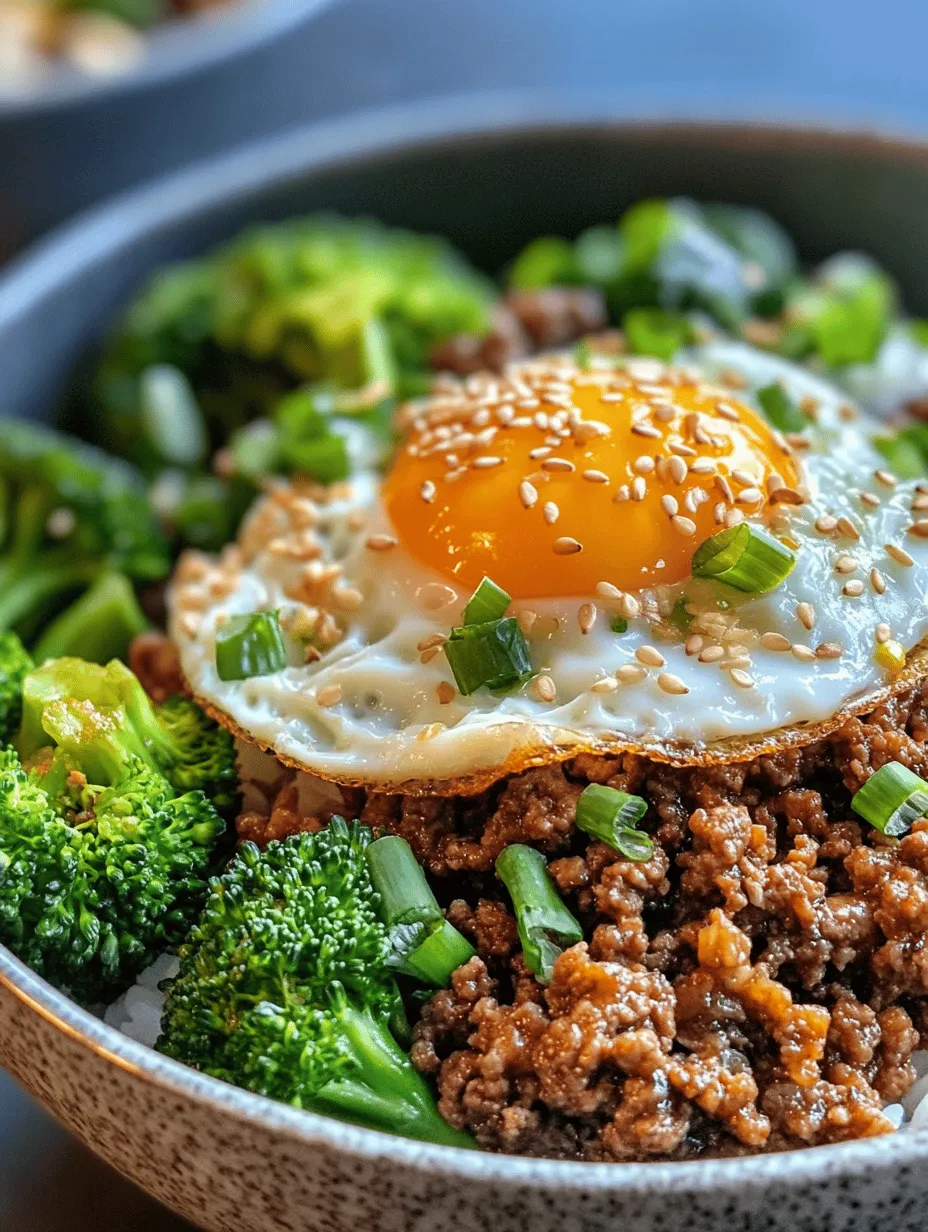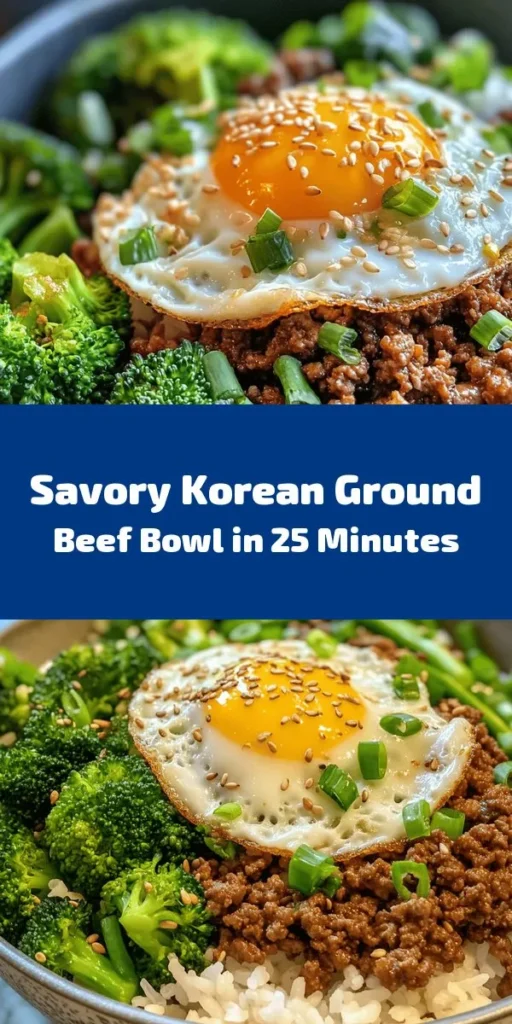Introduction
In recent years, Korean cuisine has gained immense popularity around the globe, celebrated for its bold flavors and vibrant ingredients. One dish that beautifully embodies the essence of Korean cooking is the Korean Ground Beef Bowl. This easy-to-make recipe combines savory ground beef with aromatic seasonings, fresh vegetables, and perfectly cooked rice, making it a favorite for busy weeknight dinners or meal prep. The allure of this dish lies not just in its taste but also in its ability to bring together a variety of textures and flavors that highlight the unique aspects of Korean culinary traditions.
The Korean Ground Beef Bowl serves as a canvas for creativity, allowing home cooks to customize it with seasonal vegetables and additional toppings that suit their preferences. Whether you are a seasoned cook or a novice in the kitchen, this recipe promises to deliver a satisfying meal that can be prepared in under 30 minutes. In this article, we will take a deep dive into the ingredients, preparation techniques, and cultural significance of this delightful bowl, helping you create a dish that not only satisfies your taste buds but also nourishes your body.
Understanding Korean Cuisine
To fully appreciate the Korean Ground Beef Bowl, it’s essential to explore the flavors and ingredients that define Korean cooking. Korean cuisine is known for its harmonious balance of flavors, which often includes sweet, salty, and spicy elements. This balance is not just a matter of taste; it’s deeply rooted in the philosophy of Korean cooking, where the combination of flavors is seen as a way to achieve overall harmony in a meal.
Overview of Traditional Korean Ingredients
Korean cooking features a range of traditional ingredients that are fundamental to its distinctive flavor profile. Staples such as gochujang (Korean red chili paste), doenjang (fermented soybean paste), kimchi (fermented vegetables), and various types of soy sauce are commonly used to create depth and complexity in dishes. Each ingredient plays a specific role, contributing to the overall taste and character of the meal.
Rice is another cornerstone of Korean cuisine. It is typically served with every meal and acts as a neutral base that complements the bold flavors of accompanying dishes. In the case of the Korean Ground Beef Bowl, the rice provides a comforting foundation that balances the savory beef and vibrant vegetables.
Importance of Balance in Flavors: Sweet, Salty, and Spicy
A key characteristic of Korean dishes is their intricate balance of flavors. The blend of sweetness from ingredients like brown sugar and the salty depth from soy sauce creates a complex base, while the addition of spicy elements introduces a kick that awakens the palate. This interplay of flavors is what makes Korean cuisine so captivating and enjoyable.
In the Korean Ground Beef Bowl, the specific balance of these flavors is achieved through a carefully crafted sauce that coats the ground beef, allowing the dish to be both comforting and exciting. The combination of sweet, salty, and spicy elements is not only delicious but also reflective of the Korean dining philosophy that emphasizes the enjoyment of food as a communal experience.
The Role of Rice and Vegetables in a Typical Korean Meal
Rice and vegetables are integral to Korean meals, often served alongside proteins to create a well-rounded dining experience. In the Korean Ground Beef Bowl, the rice acts as a base that soaks up the flavorful sauce, while the vegetables add freshness and texture. Common vegetables used in Korean cooking include bok choy, carrots, and green onions, all of which can be easily incorporated into this recipe.
The inclusion of vegetables not only enhances the visual appeal of the dish but also adds essential nutrients, making it a wholesome option for those looking to enjoy a balanced meal. As you prepare your Korean Ground Beef Bowl, feel free to experiment with seasonal produce or your favorite vegetables to make the dish your own.
Key Ingredients for the Korean Ground Beef Bowl
An in-depth look at what makes this recipe unique reveals several key ingredients that contribute to its savory depth and vibrant flavor. Understanding these ingredients will help you appreciate the dish even more and may inspire you to explore other Korean recipes.
Ground Beef: Choosing the Right Cut for Optimal Flavor and Texture
The foundation of the Korean Ground Beef Bowl is, of course, the ground beef. When selecting ground beef for this dish, aim for a cut with a moderate fat content, such as 80/20 (80% lean meat and 20% fat). This ratio ensures that the beef remains juicy and flavorful without becoming greasy. Ground beef from grass-fed cattle can also provide a richer taste and more nutrients, making it a worthy option for your bowl.
Soy Sauce: The Backbone of Korean Seasoning
Soy sauce is an essential ingredient in Korean cooking, acting as the backbone of flavor in many dishes. It adds umami, a savory taste that enhances the overall flavor profile. For the Korean Ground Beef Bowl, using a combination of regular soy sauce and a darker variety, such as thick soy sauce, can create a more complex flavor. The saltiness of the soy sauce balances the sweetness of other ingredients, resulting in a rich, well-rounded sauce.
Brown Sugar: Adding Depth and Sweetness
Brown sugar is another key component of the sauce that coats the ground beef. Its molasses content adds a depth of flavor that white sugar cannot replicate. The sweetness from brown sugar counteracts the saltiness of the soy sauce while contributing to the caramelization of the meat during cooking. For those looking to reduce refined sugar, alternatives like coconut sugar or maple syrup can work well without compromising flavor.
Sesame Oil: Enhancing the Dish with Its Nutty Flavor
Sesame oil is a staple in Korean kitchens, known for its rich, nutty flavor. Just a small amount can significantly elevate the taste of the Korean Ground Beef Bowl. It provides a luxurious finish to the dish and is often drizzled on top as a garnish. When selecting sesame oil, opt for toasted sesame oil for a more pronounced flavor that adds authenticity to your dish.
Aromatics: The Significance of Garlic and Ginger in Korean Cooking
Garlic and ginger are two aromatics that are indispensable in Korean cuisine, adding depth and freshness to dishes. Garlic, known for its pungent aroma and robust flavor, is often used in marinades and sauces. Ginger, with its warm and slightly spicy notes, complements garlic beautifully. For the Korean Ground Beef Bowl, finely mincing both garlic and ginger will release their essential oils, infusing the dish with their aromatic qualities.
Vegetables: Incorporating Seasonal and Fresh Produce
Vegetables play a vital role in the Korean Ground Beef Bowl, contributing not only color and texture but also essential nutrients. Common choices include sliced carrots, bell peppers, and leafy greens such as spinach or bok choy. Incorporating a variety of vegetables not only enhances the dish’s nutritional profile but also adds crunch and freshness that balances the savory beef.
Optional Additions: The Fried Egg and Its Cultural Significance
While the Korean Ground Beef Bowl can stand alone as a complete meal, adding a fried egg on top is a popular practice that takes it to the next level. The runny yolk adds richness and creates a delightful contrast with the savory beef and vegetables. In Korean culture, eggs are often seen as a symbol of prosperity and are featured in many traditional dishes. Including a fried egg on your bowl not only enhances flavor but also pays homage to this cultural significance.
Step-by-Step Preparation
Now that we have explored the key ingredients that make up the Korean Ground Beef Bowl, it’s time to dive into the step-by-step preparation. This comprehensive guide will help you create the perfect bowl, ensuring that you can replicate this delicious dish at home with ease.
Preparing the Beef Mixture: Techniques for Browning Ground Beef
To start, gather your ingredients and prepare your cooking space. Begin by heating a large skillet or frying pan over medium-high heat. Once the pan is hot, add a small amount of oil to prevent sticking. When the oil is shimmering, add the ground beef, breaking it apart with a spatula as it cooks.
Browning the ground beef is a crucial step that enhances its flavor through the Maillard reaction, which occurs when proteins and sugars in the meat react to heat. Cook the beef until it is browned and no longer pink, about 5-7 minutes, stirring occasionally to ensure even cooking. Drain any excess fat if necessary, but leave a little for flavor.
Infusing Flavor with Aromatics: How to Properly Sauté Garlic and Ginger
Once the beef is cooked, it’s time to infuse the dish with the aromatic flavors of garlic and ginger. Reduce the heat to medium and add the minced garlic and ginger to the skillet. Sauté them for about 1-2 minutes, or until fragrant, taking care not to let them burn. The goal here is to release the essential oils and flavors without overwhelming the dish.
This technique of sautéing aromatics is common in many cuisines and is essential for building a flavor base. The aroma of garlic and ginger will fill your kitchen, signaling that you’re on your way to creating a delicious meal.
Achieving the Right Sauce Consistency: Tips for Simmering and Thickening
With the aromatics sautéed, it’s time to create the sauce that will bring the dish together. In a small bowl, combine soy sauce, brown sugar, and sesame oil. Pour this mixture over the browned beef and aromatics in the skillet, stirring to ensure the beef is evenly coated.
Allow the mixture to simmer for a few minutes, letting the flavors meld together. If you prefer a thicker sauce, you can add a cornstarch slurry (a mixture of cornstarch and water) at this stage, stirring continuously until the sauce thickens to your desired consistency. This step adds a glossy sheen to the beef and enhances the overall presentation of the dish.
By carefully following these steps, you can create a Korean Ground Beef Bowl that is not only delicious but also a true reflection of the rich culinary traditions of Korea. As you prepare and savor this dish, you will gain a deeper appreciation for the flavors and techniques that make Korean cuisine so beloved around the world. Stay tuned for the next part of this article, where we will explore the final touches and tips for serving the perfect Korean Ground Beef Bowl.

Incorporating Vegetables: Timing and Technique for the Best Texture
When creating the perfect Korean Ground Beef Bowl, the incorporation of vegetables is crucial for both nutrition and texture. To achieve a delightful balance, it’s important to consider the timing and technique used during cooking.
Start by selecting your vegetables. Common choices for this dish include vibrant broccoli florets, carrots, bell peppers, and snap peas. For optimum texture, it’s best to add these vegetables at strategic points during the cooking process.
1. Preparation: Begin by washing and chopping your vegetables into bite-sized pieces. This not only helps them cook evenly but also enhances the visual appeal of your dish.
2. Cooking Method: After browning the ground beef and draining any excess fat, add the vegetables that require a longer cooking time first. For example, start with broccoli and carrots, which take about 3-5 minutes to soften. Stir them into the beef mixture and allow them to cook until they are tender yet still crisp.
3. Finishing Touches: Add quicker-cooking vegetables like bell peppers and snap peas towards the end, ideally in the last 1-2 minutes of cooking. This ensures they retain their crunch and vibrant color, contributing to a more appealing texture in the final dish.
Assembling the Bowl: Presentation Tips for an Appealing Dish
Once your Korean Ground Beef and vegetables are prepared, it’s time to assemble the bowl. Presentation plays a significant role in enjoying any meal, and this dish is no exception. Here are some tips for creating a visually appealing Korean Ground Beef Bowl:
1. Base Layer: Start with a generous scoop of jasmine rice or your chosen grain as the base. Fluff the rice with a fork to ensure it is light and airy before adding it to the bowl.
2. Layering: Carefully spoon the ground beef and vegetable mixture over the rice. This layering technique not only creates a beautiful visual but also allows the flavors to meld as the warm beef mixture slightly warms the rice.
3. Color Contrast: Use contrasting colors to enhance the dish’s appearance. Bright green vegetables, red or yellow bell peppers, and the rich brown of the beef create a vibrant and appetizing look.
4. Serving Size: Consider the portion size when assembling. Aim for a balanced bowl that’s not too overwhelming but still satisfying. Leave a little space on the top for garnishes.
Garnishing with Style: The Role of Sesame Seeds and Green Onions
The finishing touches on your Korean Ground Beef Bowl can elevate the dish, making it not only more appealing but also adding layers of flavor. Here’s how to garnish effectively:
1. Sesame Seeds: Toasted sesame seeds are a traditional garnish that adds a nutty flavor and a delightful crunch. Sprinkle a generous amount over the top of the assembled bowl to enhance both taste and presentation.
2. Green Onions: Finely chop fresh green onions and scatter them over the dish. Their bright green color provides a fresh contrast and a burst of flavor that complements the richness of the beef.
3. Optional Drizzle: For those who enjoy a little heat, consider drizzling a bit of sriracha or your favorite hot sauce over the top before serving. This not only adds a pop of color but also invites those who enjoy spicy flavors to dig in.
Nutritional Benefits
The Korean Ground Beef Bowl is not only delicious but also packed with nutritional benefits that make it a wholesome meal option.
Protein-Packed Goodness
Ground beef is an excellent source of high-quality protein, essential for muscle repair and growth. A standard serving can provide around 25 grams of protein, making it a suitable choice for those looking to meet their daily protein needs. Additionally, beef contains essential nutrients such as iron, zinc, and B vitamins, which play significant roles in overall health.
Vegetables: Nutritional Value of Broccoli and Other Additions
Incorporating vegetables like broccoli not only enhances the dish’s flavor but also boosts its nutritional profile. Broccoli is rich in vitamins C and K, fiber, and antioxidants, which support immune function and digestive health. Other vegetables added to the bowl, such as carrots and bell peppers, contribute additional vitamins and minerals, making this dish a well-rounded option.
Whole Grains: The Benefits of Jasmine Rice and Alternatives
Jasmine rice, the traditional grain used in this dish, is fragrant and slightly sticky, making it perfect for soaking up the flavorful sauce. It provides carbohydrates for energy and is a source of B vitamins. For those looking for alternatives, whole grain options like brown rice or quinoa can offer additional fiber and nutrients.
Balancing Macros: How to Adjust the Recipe for Dietary Needs
This recipe is easily adaptable to fit various dietary preferences. For a lower-carb version, consider swapping rice for cauliflower rice or zucchini noodles. To increase the fiber content, add more vegetables or use brown rice. Adjusting the amount of ground beef can also help balance the macronutrients according to individual dietary goals.
Variations and Customizations
One of the great things about the Korean Ground Beef Bowl is its versatility. Here are some ways to customize the dish to suit your taste preferences or dietary requirements.
Vegetarian and Vegan Alternatives
For those looking to enjoy a meat-free version of this dish, consider using plant-based proteins such as textured vegetable protein (TVP), lentils, or chickpeas. These ingredients can absorb the same flavorful seasonings, providing a hearty and satisfying alternative.
Gluten-Free Adjustments
For a gluten-free version, be sure to use gluten-free soy sauce or tamari instead of regular soy sauce. This modification allows you to enjoy the rich umami flavor without compromising dietary restrictions.
Spice Levels: Adjusting for Personal Taste Preferences
If you prefer a milder dish, reduce the amount of gochujang (Korean chili paste) used in the recipe. Alternatively, if you enjoy heat, feel free to add more gochujang or incorporate fresh chili peppers when cooking the beef.
Adding More Vegetables: Creative Options to Enhance Nutrition
Feel free to get creative with the vegetables you use in the bowl. Options like zucchini, bok choy, or mushrooms can add different textures and flavors. Experimenting with seasonal vegetables can also keep the dish fresh and exciting throughout the year.
Cultural Significance
Understanding the roots and traditions behind the Korean Ground Beef Bowl adds depth to the culinary experience.
The History of Korean Bowls and Their Importance in Meals
Korean bowls, known as “dosirak,” have a rich history that dates back centuries. They were often used for packed meals, especially for workers and students, highlighting the practicality of rice and various side dishes combined in one container. These bowls embody the essence of Korean cuisine, where balance, harmony, and the combination of flavors are key.
The Communal Aspect of Sharing Food in Korean Culture
In Korean culture, food is often seen as a communal experience. Meals are typically served family-style, encouraging sharing and togetherness. The Korean Ground Beef Bowl can embody this spirit when prepared for gatherings, allowing everyone to customize their bowl according to their personal preferences.
Celebrating Korean Cuisine in Modern Culinary Practices
As Korean cuisine gains popularity worldwide, dishes like the Korean Ground Beef Bowl have found their place in modern dining. This dish not only showcases traditional flavors but also adapts to contemporary dietary trends, making it a beloved choice among food enthusiasts.
Conclusion
The Korean Ground Beef Bowl is not just a meal; it’s a celebration of flavors, culture, and community. With its straightforward preparation and adaptability, this dish provides a delicious and wholesome option for anyone looking to explore Korean cuisine. Whether you’re entertaining guests or enjoying a cozy night in, this recipe promises to deliver comfort and satisfaction in every bite. Embrace the essence of Korean cooking and enjoy the process of creating this delightful bowl at home. Dive into the rich traditions of Korean dining, and savor the delightful mix of textures and flavors that make this dish a unique culinary experience.



